Antibody data
- Antibody Data
- Antigen structure
- References [19]
- Comments [0]
- Validations
- Immunohistochemistry [3]
- Flow cytometry [1]
- Other assay [21]
Submit
Validation data
Reference
Comment
Report error
- Product number
- 51-3900 - Provider product page

- Provider
- Invitrogen Antibodies
- Product name
- ALK Polyclonal Antibody
- Antibody type
- Polyclonal
- Antigen
- Recombinant full-length protein
- Reactivity
- Human
- Host
- Rabbit
- Isotype
- IgG
- Vial size
- 100 μg
- Concentration
- 0.25 mg/mL
- Storage
- -20°C
Submitted references Aberrant role of ALK in tau proteinopathy through autophagosomal dysregulation.
Anaplastic Lymphoma Kinase Regulates Internalization of the Dopamine D2 Receptor.
ALK oncoproteins in atypical inflammatory myofibroblastic tumours: novel RRBP1-ALK fusions in epithelioid inflammatory myofibroblastic sarcoma.
Harnessing Connectivity in a Large-Scale Small-Molecule Sensitivity Dataset.
Ethanol activates midkine and anaplastic lymphoma kinase signaling in neuroblastoma cells and in the brain.
Selective ALK inhibitor alectinib with potent antitumor activity in models of crizotinib resistance.
A novel mechanism of EML4-ALK rearrangement mediated by chromothripsis in a patient-derived cell line.
Wild-type ALK and activating ALK-R1275Q and ALK-F1174L mutations upregulate Myc and initiate tumor formation in murine neural crest progenitor cells.
Antineoplastic activity of the DNA methyltransferase inhibitor 5-aza-2'-deoxycytidine in anaplastic large cell lymphoma.
PDGFR blockade is a rational and effective therapy for NPM-ALK-driven lymphomas.
CH5424802, a selective ALK inhibitor capable of blocking the resistant gatekeeper mutant.
ALK rearrangement in sickle cell trait-associated renal medullary carcinoma.
Anaplastic lymphoma kinase is activated through the pleiotrophin/receptor protein-tyrosine phosphatase beta/zeta signaling pathway: an alternative mechanism of receptor tyrosine kinase activation.
Effects of pleiotrophin, a heparin-binding growth factor, on human primary and immortalized chondrocytes.
Stat3 is required for ALK-mediated lymphomagenesis and provides a possible therapeutic target.
Differential induction of glioblastoma migration and growth by two forms of pleiotrophin.
Truncated ALK derived from chromosomal translocation t(2;5)(p23;q35) binds to the SH3 domain of p85-PI3K.
NPM-ALK transgenic mice spontaneously develop T-cell lymphomas and plasma cell tumors.
Anaplastic lymphoma kinase (ALK) activates Stat3 and protects hematopoietic cells from cell death.
Park J, Choi H, Kim YD, Kim SH, Kim Y, Gwon Y, Lee DY, Park SH, Heo WD, Jung YK
Molecular psychiatry 2021 Oct;26(10):5542-5556
Molecular psychiatry 2021 Oct;26(10):5542-5556
Anaplastic Lymphoma Kinase Regulates Internalization of the Dopamine D2 Receptor.
He D, Lasek AW
Molecular pharmacology 2020 Feb;97(2):123-131
Molecular pharmacology 2020 Feb;97(2):123-131
ALK oncoproteins in atypical inflammatory myofibroblastic tumours: novel RRBP1-ALK fusions in epithelioid inflammatory myofibroblastic sarcoma.
Lee JC, Li CF, Huang HY, Zhu MJ, Mariño-Enríquez A, Lee CT, Ou WB, Hornick JL, Fletcher JA
The Journal of pathology 2017 Feb;241(3):316-323
The Journal of pathology 2017 Feb;241(3):316-323
Harnessing Connectivity in a Large-Scale Small-Molecule Sensitivity Dataset.
Seashore-Ludlow B, Rees MG, Cheah JH, Cokol M, Price EV, Coletti ME, Jones V, Bodycombe NE, Soule CK, Gould J, Alexander B, Li A, Montgomery P, Wawer MJ, Kuru N, Kotz JD, Hon CS, Munoz B, Liefeld T, Dančík V, Bittker JA, Palmer M, Bradner JE, Shamji AF, Clemons PA, Schreiber SL
Cancer discovery 2015 Nov;5(11):1210-23
Cancer discovery 2015 Nov;5(11):1210-23
Ethanol activates midkine and anaplastic lymphoma kinase signaling in neuroblastoma cells and in the brain.
He D, Chen H, Muramatsu H, Lasek AW
Journal of neurochemistry 2015 Nov;135(3):508-21
Journal of neurochemistry 2015 Nov;135(3):508-21
Selective ALK inhibitor alectinib with potent antitumor activity in models of crizotinib resistance.
Kodama T, Tsukaguchi T, Yoshida M, Kondoh O, Sakamoto H
Cancer letters 2014 Sep 1;351(2):215-21
Cancer letters 2014 Sep 1;351(2):215-21
A novel mechanism of EML4-ALK rearrangement mediated by chromothripsis in a patient-derived cell line.
Kodama T, Motoi N, Ninomiya H, Sakamoto H, Kitada K, Tsukaguchi T, Satoh Y, Nomura K, Nagano H, Ishii N, Terui Y, Hatake K, Ishikawa Y
Journal of thoracic oncology : official publication of the International Association for the Study of Lung Cancer 2014 Nov;9(11):1638-46
Journal of thoracic oncology : official publication of the International Association for the Study of Lung Cancer 2014 Nov;9(11):1638-46
Wild-type ALK and activating ALK-R1275Q and ALK-F1174L mutations upregulate Myc and initiate tumor formation in murine neural crest progenitor cells.
Montavon G, Jauquier N, Coulon A, Peuchmaur M, Flahaut M, Bourloud KB, Yan P, Delattre O, Sommer L, Joseph JM, Janoueix-Lerosey I, Gross N, Mühlethaler-Mottet A
Oncotarget 2014 Jun 30;5(12):4452-66
Oncotarget 2014 Jun 30;5(12):4452-66
Antineoplastic activity of the DNA methyltransferase inhibitor 5-aza-2'-deoxycytidine in anaplastic large cell lymphoma.
Hassler MR, Klisaroska A, Kollmann K, Steiner I, Bilban M, Schiefer AI, Sexl V, Egger G
Biochimie 2012 Nov;94(11):2297-307
Biochimie 2012 Nov;94(11):2297-307
PDGFR blockade is a rational and effective therapy for NPM-ALK-driven lymphomas.
Laimer D, Dolznig H, Kollmann K, Vesely PW, Schlederer M, Merkel O, Schiefer AI, Hassler MR, Heider S, Amenitsch L, Thallinger C, Staber PB, Simonitsch-Klupp I, Artaker M, Lagger S, Turner SD, Pileri S, Piccaluga PP, Valent P, Messana K, Landra I, Weichhart T, Knapp S, Shehata M, Todaro M, Sexl V, Höfler G, Piva R, Medico E, Ruggeri BA, Cheng M, Eferl R, Egger G, Penninger JM, Jaeger U, Moriggl R, Inghirami G, Kenner L
Nature medicine 2012 Nov;18(11):1699-704
Nature medicine 2012 Nov;18(11):1699-704
CH5424802, a selective ALK inhibitor capable of blocking the resistant gatekeeper mutant.
Sakamoto H, Tsukaguchi T, Hiroshima S, Kodama T, Kobayashi T, Fukami TA, Oikawa N, Tsukuda T, Ishii N, Aoki Y
Cancer cell 2011 May 17;19(5):679-90
Cancer cell 2011 May 17;19(5):679-90
ALK rearrangement in sickle cell trait-associated renal medullary carcinoma.
Mariño-Enríquez A, Ou WB, Weldon CB, Fletcher JA, Pérez-Atayde AR
Genes, chromosomes & cancer 2011 Mar;50(3):146-53
Genes, chromosomes & cancer 2011 Mar;50(3):146-53
Anaplastic lymphoma kinase is activated through the pleiotrophin/receptor protein-tyrosine phosphatase beta/zeta signaling pathway: an alternative mechanism of receptor tyrosine kinase activation.
Perez-Pinera P, Zhang W, Chang Y, Vega JA, Deuel TF
The Journal of biological chemistry 2007 Sep 28;282(39):28683-28690
The Journal of biological chemistry 2007 Sep 28;282(39):28683-28690
Effects of pleiotrophin, a heparin-binding growth factor, on human primary and immortalized chondrocytes.
Pufe T, Groth G, Goldring MB, Tillmann B, Mentlein R
Osteoarthritis and cartilage 2007 Feb;15(2):155-62
Osteoarthritis and cartilage 2007 Feb;15(2):155-62
Stat3 is required for ALK-mediated lymphomagenesis and provides a possible therapeutic target.
Chiarle R, Simmons WJ, Cai H, Dhall G, Zamo A, Raz R, Karras JG, Levy DE, Inghirami G
Nature medicine 2005 Jun;11(6):623-9
Nature medicine 2005 Jun;11(6):623-9
Differential induction of glioblastoma migration and growth by two forms of pleiotrophin.
Lu KV, Jong KA, Kim GY, Singh J, Dia EQ, Yoshimoto K, Wang MY, Cloughesy TF, Nelson SF, Mischel PS
The Journal of biological chemistry 2005 Jul 22;280(29):26953-64
The Journal of biological chemistry 2005 Jul 22;280(29):26953-64
Truncated ALK derived from chromosomal translocation t(2;5)(p23;q35) binds to the SH3 domain of p85-PI3K.
Polgar D, Leisser C, Maier S, Strasser S, Rüger B, Dettke M, Khorchide M, Simonitsch I, Cerni C, Krupitza G
Mutation research 2005 Feb 15;570(1):9-15
Mutation research 2005 Feb 15;570(1):9-15
NPM-ALK transgenic mice spontaneously develop T-cell lymphomas and plasma cell tumors.
Chiarle R, Gong JZ, Guasparri I, Pesci A, Cai J, Liu J, Simmons WJ, Dhall G, Howes J, Piva R, Inghirami G
Blood 2003 Mar 1;101(5):1919-27
Blood 2003 Mar 1;101(5):1919-27
Anaplastic lymphoma kinase (ALK) activates Stat3 and protects hematopoietic cells from cell death.
Zamo A, Chiarle R, Piva R, Howes J, Fan Y, Chilosi M, Levy DE, Inghirami G
Oncogene 2002 Feb 7;21(7):1038-47
Oncogene 2002 Feb 7;21(7):1038-47
No comments: Submit comment
Supportive validation
- Submitted by
- Invitrogen Antibodies (provider)
- Main image
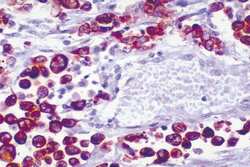
- Experimental details
- Immunohistochemical staining of ALCL tissue using ALK Polyclonal Antibody, Rabbit, (PAD: ZAL4). Image courtesy of Dr. G. Inghirami, NYU.
- Submitted by
- Invitrogen Antibodies (provider)
- Main image
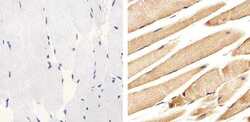
- Experimental details
- Immunohistochemistry analysis of ALK showing staining in the cytoplasm of paraffin-embedded human skeletal muscle tissue (right) compared to a negative control without primary antibody (left). To expose target proteins, antigen retrieval was performed using 10mM sodium citrate (pH 6.0), microwaved for 8-15 min. Following antigen retrieval, tissues were blocked in 3% H2O2-methanol for 15 min at room temperature, washed with ddH2O and PBS, and then probed with ALK Polyclonal Antibody (Product # 51-3900) diluted in 3% BSA-PBS at a dilution of 1:100 overnight at 4ºC in a humidified chamber. Tissues were washed extensively in PBST and detection was performed using an HRP-conjugated secondary antibody followed by colorimetric detection using a DAB kit. Tissues were counterstained with hematoxylin and dehydrated with ethanol and xylene to prep for mounting.
- Submitted by
- Invitrogen Antibodies (provider)
- Main image
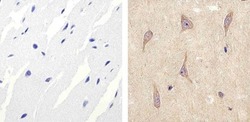
- Experimental details
- Immunohistochemistry analysis of ALK showing staining in the cytoplasm of paraffin-embedded human brain tissue (right) compared to a negative control without primary antibody (left). To expose target proteins, antigen retrieval was performed using 10mM sodium citrate (pH 6.0), microwaved for 8-15 min. Following antigen retrieval, tissues were blocked in 3% H2O2-methanol for 15 min at room temperature, washed with ddH2O and PBS, and then probed with a ALK polyclonal antibody (Product # 51-3900) diluted in 3% BSA-PBS at a dilution of 1:100 overnight at 4ºC in a humidified chamber. Tissues were washed extensively in PBST and detection was performed using an HRP-conjugated secondary antibody followed by colorimetric detection using a DAB kit. Tissues were counterstained with hematoxylin and dehydrated with ethanol and xylene to prep for mounting.
Supportive validation
- Submitted by
- Invitrogen Antibodies (provider)
- Main image
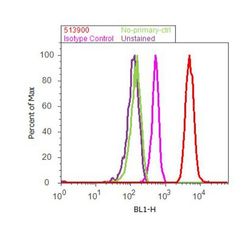
- Experimental details
- Flow cytometry analysis of ALK was done on HCT 116 cells. Cells were fixed with 70% ethanol for 10 minutes, permeabilized with 0.25% Tritonª X-100 for 20 minutes, and blocked with 5% BSA for 30 minutes at room temperature. Cells were labeled with ALK Rabbit Polyclonal Antibody (513900, red histogram) or with rabbit isotype control (pink histogram) at 3-5 µg/million cells in 2.5% BSA. After incubation at room temperature for 2 hours, the cells were labeled with Alexa Fluor¨ 488 Goat Anti-Rabbit Secondary Antibody (A11008) at a dilution of 1:400 for 30 minutes at room temperature. The representative 10,000 cells were acquired and analyzed for each sample using an Attune¨ Acoustic Focusing Cytometer. The purple histogram represents unstained control cells and the green histogram represents no-primary-antibody control.
Supportive validation
- Submitted by
- Invitrogen Antibodies (provider)
- Main image
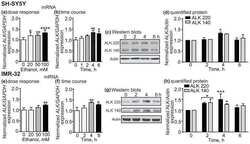
- Experimental details
- NULL
- Submitted by
- Invitrogen Antibodies (provider)
- Main image
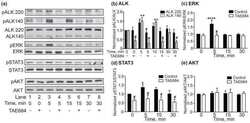
- Experimental details
- NULL
- Submitted by
- Invitrogen Antibodies (provider)
- Main image
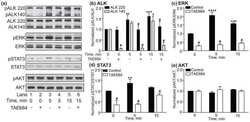
- Experimental details
- NULL
- Submitted by
- Invitrogen Antibodies (provider)
- Main image
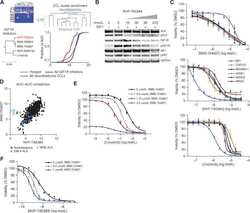
- Experimental details
- NULL
- Submitted by
- Invitrogen Antibodies (provider)
- Main image
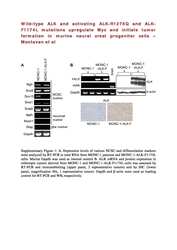
- Experimental details
- NULL
- Submitted by
- Invitrogen Antibodies (provider)
- Main image
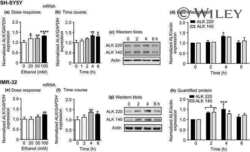
- Experimental details
- NULL
- Submitted by
- Invitrogen Antibodies (provider)
- Main image
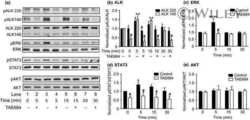
- Experimental details
- NULL
- Submitted by
- Invitrogen Antibodies (provider)
- Main image
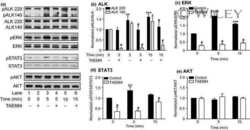
- Experimental details
- NULL
- Submitted by
- Invitrogen Antibodies (provider)
- Main image
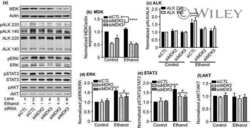
- Experimental details
- NULL
- Submitted by
- Invitrogen Antibodies (provider)
- Main image
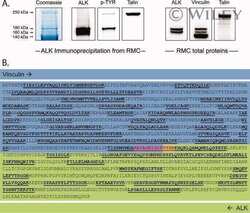
- Experimental details
- NULL
- Submitted by
- Invitrogen Antibodies (provider)
- Main image
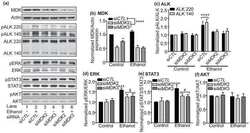
- Experimental details
- NULL
- Submitted by
- Invitrogen Antibodies (provider)
- Main image
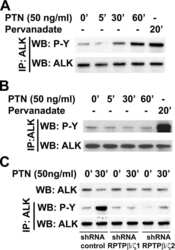
- Experimental details
- NULL
- Submitted by
- Invitrogen Antibodies (provider)
- Main image
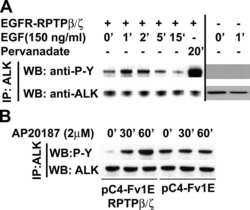
- Experimental details
- NULL
- Submitted by
- Invitrogen Antibodies (provider)
- Main image
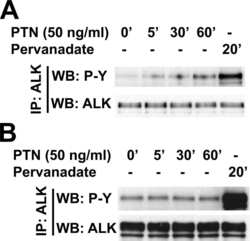
- Experimental details
- NULL
- Submitted by
- Invitrogen Antibodies (provider)
- Main image
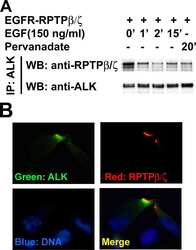
- Experimental details
- NULL
- Submitted by
- Invitrogen Antibodies (provider)
- Main image
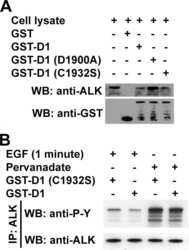
- Experimental details
- NULL
- Submitted by
- Invitrogen Antibodies (provider)
- Main image
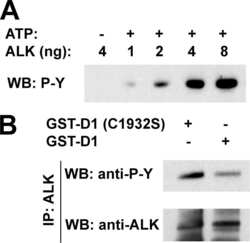
- Experimental details
- NULL
- Submitted by
- Invitrogen Antibodies (provider)
- Main image
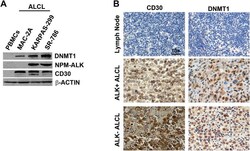
- Experimental details
- Fig. 1 Enhanced DNMT1 expression is detected in human ALCL cell lines and patient samples. A. DNMT1 is overexpressed in human ALCL cell lines compared to normal peripheral blood mononuclear cells (PBMCs). Proteins were extracted from PBMCs, ALK- ALCL cell line MAC-2A and ALK+ ALCL cell lines KARPAS-299 and SR-786 and analysed by Western Blot as described in materials and methods. B. DNMT1 is expressed in human ALK+ ALCL tumor cells, but not in healthy lymph nodes. Immunohistochemical staining against DNMT1 was performed on a human ALCL tissue array containing 30 ALK+ and 5 ALK- ALCL patient samples and 7 normal lymph nodes as controls. One representative lymph node, one representative ALK+ and one ALK- ALCL sample are shown. CD30 is used as diagnostic marker for ALCL. Note the typical abnormal anaplastic large cell morphology of CD30 positive cells compared to healthy lymphocytes.
- Submitted by
- Invitrogen Antibodies (provider)
- Main image
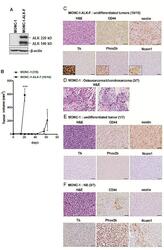
- Experimental details
- Figure 1 ALK-F1174L impairs differentiation of MONC-1-derived tumors A. Whole cell extract of MONC-1 parental cells and MONC-1-ALK-F1174L transduced cells were analyzed by immunoblotting for the presence of human ALK. beta-actin was used as loading control. B. Tumor take (number of tumor-bearing mice /total nude mice) and growth (mean tumor volumes +- SEM) of MONC-1 and MONC-1-ALK-F cells orthotopically implanted and measured by echography (unpaired t test with Welch's correction, ***=p
- Submitted by
- Invitrogen Antibodies (provider)
- Main image

- Experimental details
- Figure 2 ALK-wt-, ALK-F1174L-, and ALK-R1275Q-expressing JoMa1 cells are tumorigenic in subcutaneous in vivo model A. Analyses of ALK mRNA and protein expressions in parental JoMa1 cells and in JoMa1 cells transduced with the empty vector (Migr) or vector encoding for ALF-wt, ALK-F1174L or ALK-R1275Q. Murine GAPDH and beta-actin were used as control for RT-PCR (top) or immunoblotting (bottom), respectively. B. Expression levels of various NCSC and differentiation markers analyzed by RT-PCR in total RNA from JoMa1 parental and transduced cells. C. Immunoblotting analysis of ALK phosphorylation in transduced JoMa1 cells. beta-actin was used as loading control. D. Tumor take (number of tumors/total implanted mouse flanks) and growth (mean tumor volumes +- SEM) of JoMa1 parental and transduced cells implanted subcutaneously in both flanks of nude mice are represented (one way Anova *=p
- Submitted by
- Invitrogen Antibodies (provider)
- Main image
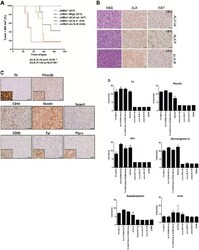
- Experimental details
- Figure 3 In vivo orthotopic implantations of ALK-wt, ALK-F1174L, and ALK-R1275Q cells generate undifferentiated NC cell-derived tumors A. Kaplan-Meier survival curves of orthotopically engrafted mice. Orthotopic tumor growth was followed by echography and mice were sacrificed once tumor on left AG reached approximately 800 mm 3 : JoMa1-ALK-F1174L, JoMa1-ALK-R1275Q, and JoMa1-ALK-wt group of mice were sacrificed from 24 to 35, 44 to 59, and 52 to 73 days post-injection, respectively (Gehan-Breslow-Wilcoxon test). All remaining mice were sacrificed 3 months post-injection. B. H&E and IHC staining for ALK and Ki67 of one representative orthotopic tumor of JoMa1-ALK-wt, -ALK-F1174L, and -ALK-R1275Q groups (magnification 40x, scale = 20 mum). C. IHC of various markers in one orthotopic JoMa1-ALK-F1174L tumor representative of all subcutaneous and orthotopic tumors (magnification 40x, scale = 20 mum). Positive controls for Th (ganglion), Phox2b (NB), CD99 (islet of Langerhans), Tyr (melanoma), and Ptprc (CD45) (spleen) are shown in small inserts. D. Bare graph showing expression levels of different genes in JoMa1-ALK tumors, NB murine transgenic model, JoMa1 cell lines, and adrenal glands.
 Explore
Explore Validate
Validate Learn
Learn Western blot
Western blot Immunohistochemistry
Immunohistochemistry